~ ST. PAUL'S CHURCH ~
CHURCH STREET, CANTERBURY
Possibly of the 13th century, Partially rebuilt in 1876
It's a very lovely church, with wonderful people
J. M. Cowper, Registers of St. Paul's, Canterbury 1562-1880 available from KFHS
Plans of the enlarged church (1854-56) on "churchplansonline.org" *ground plan created by George Gilbert Scott
IGI has christenings and marriages 1562-1800
*The church had no burial ground of it's own, and the parishioners used that of St. Augustine's Abbey until 1591, when the ground in Longport was purchased and consecrated
Joseph HATCH, the celebrated founder of bells, was married at St. Paul's in 1607.
March 1795 - Marriage at St. Paul's in Canterbury, Mr. John Hollingbery STRINGER, taylor and woolen-draper, to Miss WHITFIELD, eldest daughter of the late John WHITFIELD, esq. of that city. KR
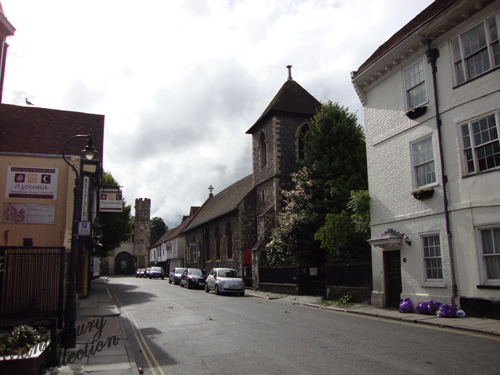
The enlargement of St. Paul's Church is due to the late Rev. W. J. Chesshyre, M.A. for 17 years rector of St. Martin's with St. Paul's. To his memory the handsome west window was erected by public subscription in 1859. The south aisle was erected by him, and other extensive improvements carried out. The chancel was enlarged and a new four light east window with good Decorated tracery and stained glass, was erected to the memory of William Henry Furley, Esq. A handsome new reredos has since been placed below it. The north aisle also contains a new three-light east window. The chancel has a memorial window to the Rev. W. A. Newman, formerly Dean of Cape Town, and in the new woulth aisle is a window to the late Mr. John Lancefield. The font is new, and replaced an ancient one, the square basin of which stood on four marble columns.

1790 - Provision for a new burial ground St. Pauls Cemetery
1865 - The taking down of the vicarage and the selling off of the materials DCb
1918 - Stained glass commemorating R.A. Delasaux
1950 - Restoration of the War damaged windows
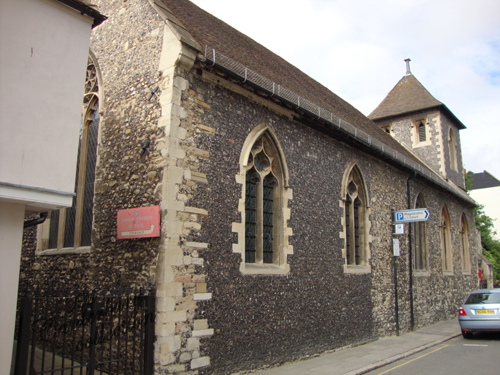
St. Paul's (situated in Church Street, St. Paul's). This church has undergone considerable alteration; it is beautifully fitted up, having an elegant altar and reredos, with choir stalls on either side of the chancel, and low open seats in the body of the church. It is believed to have been built in the reign of Henry III. The living is a vicarage, united with that of St. Martin. 1889
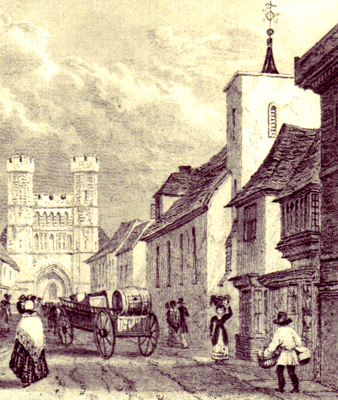
Detail of St. Paul's Church, with the Cemetery Gate in the background
St. Paul's Church
Which is without the city walls, is situate in Church Street, towards the east end of Burgate Street on the south side. One view takes in the church and St. Ethelbert's Gate, standing still further eastward. The patronage formerly belonged to St. Augustine's. [The church has within the last few years been enlarged, nay almost rebuilt. The old church with its round early English pillars might date from the reign of Henry III. It is now one of the finest churches in Canterbury - simple, chaste, and even plain, it has a certain impressiveness about it that cannot fail to please. It had several incised monumental brasses] - one, though much worn, of George and Katherine Winburne, still remains unmutilated. "In the city's registrar of wills, A.D. 1386, notice is taken of the four-headed crouch, or cross, in Saint Paul's, within the city's liberty." (BM) COT1860
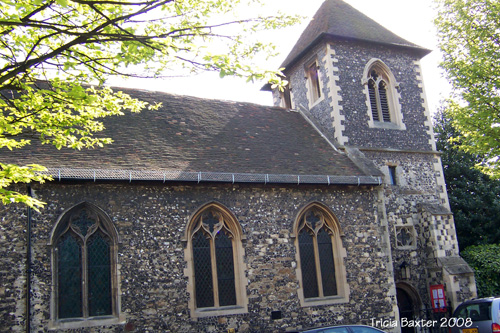
Mr. Richard Best was buried in the chancel of St. Paul's, Canterbury, October 13, 1633, his wife survived him, and resided in the parish of St. Cosmas and Damian-upon-the-Bleane, Kent; her will was dated 5 Oct. 1662, and proved 29 Oct. same year: she died at Wellcourt, and was buried in the chancel of St. Paul's Church, Canterbury, near her husband, 13 Oct. 1662.
Mr. John Best, died in 1666, and was buried at St. Paul's, Canterbury, 14 Dec. in that year.

An old glass slide in my collection, St. Paul's Church on the right and the Cemetery Gate in the distance
An old photograph in my collection, St. Paul's Church on the right and the Cemetery Gate in the distance
Marriage - March 4th, 1794 at St. Paul's in Canterbury, Mr. John Hotlingbery STRINGER, taylor and woollen draper, to Miss WHITFIELD, eldest daughter of the late John WHITFIELD esq. of that city. KR
Marriage - August 6th, at St. Paul's church, Canterbury, Mr. George HARVEY, cabinet maker, to Miss Henrietta Mary YEOMANS, both of this city. Kentish Gazette, Aug 11, 1835
Marriage - August 10th, at St. Paul's Church, Canterbury, Mr. Wm. JENNINGS, butcher to Miss Mary Ann MASON, both of this city. Kentish Gazette, Aug 11, 1835

1838
Patrons, The Archbishop and The Dean and Chapter of Canterbury, alternately
Incumbent & Rector - J. Edward Nassau MOLESWORTH
Churchwardens:
G. WHITE, Bridge Street
Thomas COLLARD, St. Lawrence
Parish Clerk, W. COLE, Broad Street
Sexton, W. MILLS, St. Martin's Hill
"Geo. Wyndbourne, Gent., 1531, not in arm., and w. Kath., with 3 sons and 5 daus., pecul., S.A., p. 215"
A manual of monumental brasses
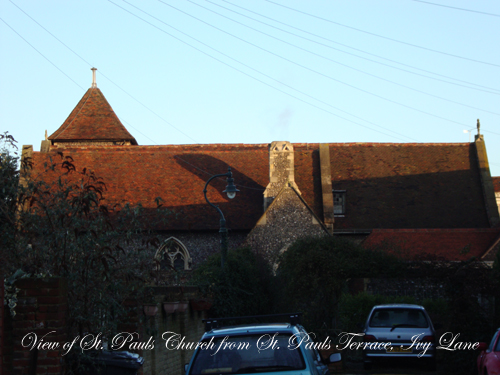
The back view of St. Paul's Church, Canterbury
St. Paul's church stands on the south side of the street of that name, within the city liberty, at a small distance without Burgate, in the high road to Deal and Sandwich. It is a small mean building, consisting of two isles and two chancels, having a square tower at the west end, in which hang three bells.
In this church, among others, are the following monuments and gravestones, viz. A mural monument, in the south isle, for Sir Edward Master; arms, Gules, a lion rampant, holding in its paws a rose branch, or. Another for lieutenant John Toker, obt. 1713; arms, Vert, on a bend argent, three hearts, gules. In the north isle, a mural monument for Sir William Rooke, of St. Laurence, in this parish, obt. 1690; arms, Argent, on a chevron engrailed, three chessrooks, between as many Cornish choughs, sable. A memorial against the wall, for George Fineux, gent. obt. 1653, second son of Thomas Fineux, esq. of Hougham, near Dover, ob. 1654; arms, Vert, a chevron, between three eagles, displayed, or. On a brass plate against the easternmost pillar, an inscription for Master Edmund Hovynden, once vicar, who died July 24, 1497. On tablets against the wall, inscriptions for the Daniels's and Nickols's. A brass plate for George Wyndbourn, gent. and Katherine his wife. He died 1531. A tablet for Mr. Nathaniel Price, obt. 1787, citizen and goldsmith, of London, and seventeen years inhabitant of this parish. Also for Nath. Price, his son, obt. 1793. A memorial for Thomas Stoughton, gent. obt. 1611. A brass plate for John Twyne, esq. (the learned antiquary) obt. 1581, who was a schoolmaster, and taught the Latin tongue, and had been mayor of this city.
__
Masters family memorials from St. Pauls Church - 2011
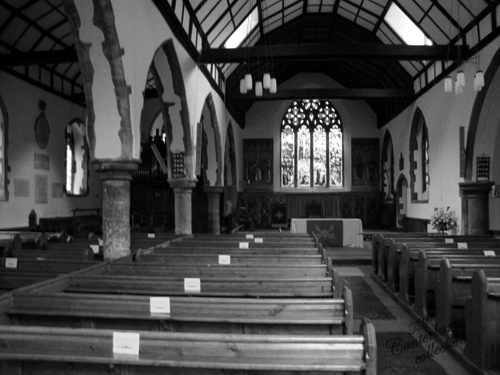
In the south isle a memorial for Mrs. Anne Masters, obt. 1716. A memorial for Johnson Macaree, esq. obt. 1786*; likewise for Johnson Macaree, esq. his son, obt. 1798. One for Edward Master, son of Sir Edward Master, obt. 1675. Hugh, son of the above. A memorial for Sir Edward Master, obt. 1690. His lady, obt. the same year. Besides which there are memorials for the Taddys, Waddells, Hollingberrys, Pembrokes, Tolputts, Worger, Hodson, Mantells, and several others.
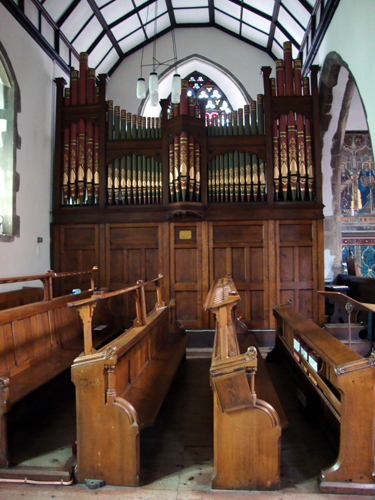
Besides the above, there are entries in the parish resgister, which begins in 1562, of the burials of several of the Masters, Bests of St. Laurence; Randolphs, lady Dorcas Master in 1671; of Fynch Rooke, esq. in 1696, who was killed in a duel, on March 8th, that year (see below), in the Northholmes, fought with Ensign Anthony Buckeridge; they both died in the field. Lady Mary Rooke, from St. Laurence, in 1699. Captain Thomas Rooke in 1701. The lady Rooke, jun. in 1702. Sir George Rooke in 1708. Dame Jane Rooke, widow of Sir William Rooke, in 1711. Geo. Rooke, esq. the last heir male of this family, in 1739.
Admiral of the Fleet Sir George Rooke, from the Beaney Museum courtesy of Craig Bowen
He is buried in St. Paul's Church, Canterbury
You can read his journal here - copy and paste the link into your browser https://archive.org/details/journalofsirgeor00rookrich
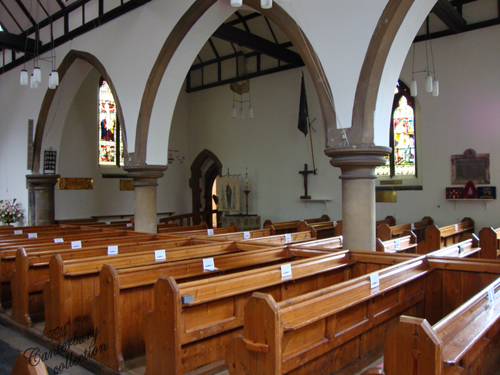
David Ferne, the short man, born in the sire of Ross, in the parish of Ferne, aet. 27, was buried here in 1737. He was 30 inches high, from head to foot, and 36 inches round, as appears by the entry made in the Register.
At the bottom part of the chancel window, says Mr. Somner, there was in antient character or letter, Magister Hamo Doge, a man of note in king Henry III.'s reign, who was official to the archbishop, and the last rector of this church before the erecting a vicarage in it. He was founder of a chantry in this parish, and for some time held the aldermany of Westgate ward. John Twyne, the antiquary, above mentioned, who was great great grandson of Sir Bryan Twyne, of Long Parish, in Hampshire, by Alice his wife, daughter of William Piper, of Canterbury. - See an account of him in Wood's Ach. vol. i. col. 202. 387.
Richard Cram, of this parish, anno 1490, gave 6s. 8d. for a new pair of organs, to serve God, in this church. HT

"Death at Canterbury, February 4th, Mrs. Anthony Clarke. At her house, the Priory, near St. Augustine's Abbey Gate, Canterbury, aged nearly 75, Mrs. Anthony Clarke. Mrs. Clarke was the last descendant of one of the most considerable of the Huguenot or Walloon Refugees, who settled at Canterbury, about the year 1572. The original name was De Macaire. She was the daughter of Johnson Macaree, esq. of Canterbury, who died 12 Dec. 1786, aged 62, by Anne Knowler, a grand-daughter of the Rev. William Elstob, the learned Saxon scholar, brother to the still more celebrated Saxonist Mrs. Elizabeth Elstob. An interesting account of this learned family will be found in Nichols's Literary Ancedotes, IV. 112-140. By the mother's side the Elstobs were descended from the old kings or princes of Wales; and Mrs. E. Elstob had drawn a pedigree of her family, which passed with the Earl of Oxford's Collection into the British Museum (Harl. MSS. No.1397. 241. b.) and a beautifully illuminated copy, with the necessary additions, was in the possession of the late Mrs. Clarke.
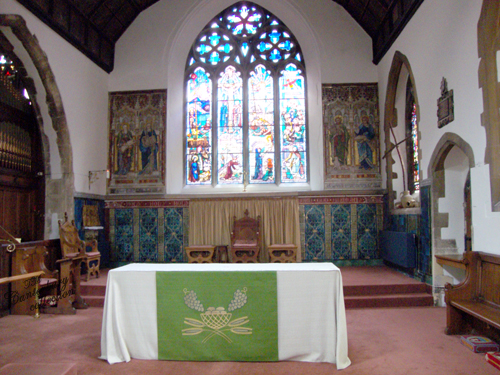
Mrs. Clarke married the late Anthony Clarke Esq. formerly of the Stock Exchange who with his lady retired from the metropolis some years since to her family house at Canterbury, where he died April 3, 1830, aged 72. He was a benevolent man, and author of some well-meant religious tracts. Mrs. Clarke's character might appear to the world to be somewhat eccentric; but it may safely be said, she was beloved by all her dependents and poor neighbours, and highly valued, as well as deeply loved, by the few who knew her intimately. Her house, called Priory, was built on part of the out-buildings of St. Augustine's Monastery; some interesting fragments of St. Ethelbert's Tower, which fell down fourteen years since, were to be seen disposed as mimic ruins in her garden. She died of gradual decay, her life having been prolonged by all the care that medical skill and watchful affection could supply. She left her property and house (which was filled with curiosities) to her faithful companion Miss James for life, and after her decease to her friend the Hon. Mrs. Stuart, widow of the late Archbishop of Armagh. By an arrangement between these ladies, her books, furniture, pictures, and other curiosities, have been lately sold by auction." GM 1835 pg 544 545
*Johnson Macaree of Cant esq. bach (24) & Ann Knowler of St. And Cant sp (21), at St. And, St. Mart, St. Alp Cant or Patrixbourne. 27 Nov
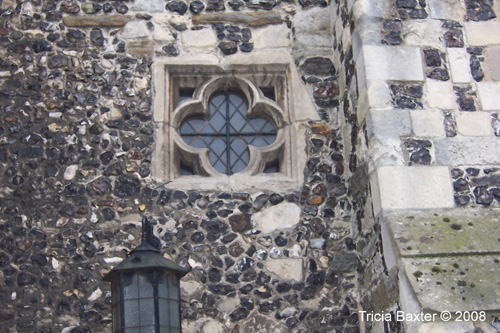
St. Paul's Church "the window above the door", the photograph generously taken by Tricia Baxter
"St. Paul's church situated on the south side of Church street, St. Paul's is a low building, comprising two aisles and two chancels, with a square tower of rude construction. The church is believed to have been built in the reign of Henry III. Its pillars are in the early English style, and the font is very curious, being square, and supported by four small pillars. Against the wall there is a small epitaph in brass of the date of 1581. Two new windows, with stone mullions and beautified with stained glass have recently been put in the chancel. The altar piece, the pews, the whitewashing, and paint, disfigure what must have originally been a fine old church. It was made a vicarage in 1268, and in 1681 was united to St. Martin's. The patronage is vested in the Archbishop and Dean and Chapter alterately. In 1588 here were one hundred and ninety-six communicants."1847D
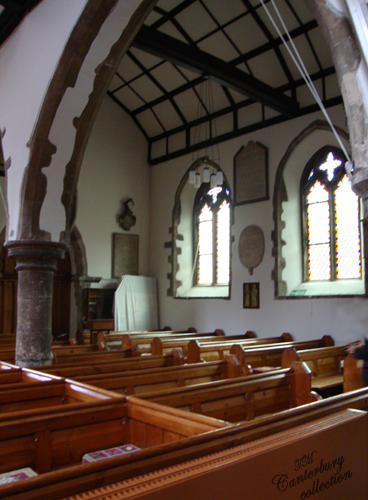
"This church has undergone considerable alteration; it is beautifully fitted up, having an elegant altar and reredos, with choir stalls on either side of the chancel, and low open seats in the body of the church. It is believed to have been built in the reign of Henry III."1889D
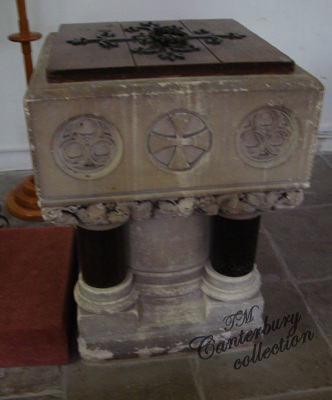
"Returning to the city by way of Longport Street, and entering Church street, the church of St. Paul's will be found abutting St. Paul's street on the left. The church, though much restored, has some thirteenth century work remaining. A good early thirteenth century font of Purbeck marble has quite recently been discarded in favour of a somewhat vulgar modern successor. The bowl of the old font remains at the east end of the south aisle. There are brasses to George and Katherine Winburne, 1431."
Canterbury; A history of the Ancient City, J. Cox 1905
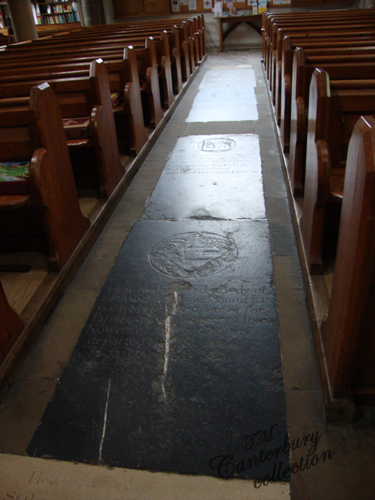
Showing Masters memorials in the aisle
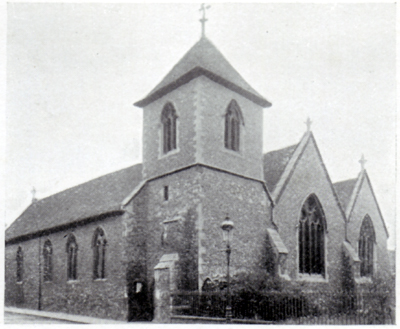
c. 1900's
Mr. Richard Best was buried in the chancel of St. Paul's Canterbury, 13 Oct. 1633; his wife survived him, and resided in the parish of St. Cosmas and Damian-upon-the-Bleane, Kent; her will was dated 5 Oct. 1662, and proved 29 Oct. same year; she d. at Wellcourt, and was buried in the chancel of St. Paul's church, Canterbury, near her husband, 13 Oct. 1662.
John Best Esq. of St. Lawrence, near Canterbury, the son and heir of Richard, s. his father in 1633, but sold the St. Lawrence estate before 1654 to William Rooke, Esq. He married Katherine, daughter of John Allanson, Esq. of Norwood, in Middlesex, and had issue,
Richard, aged 12 at the Visitation of 1663
John living in 1663
William, bapt. at St. Paul's, Canterbury, 21 Aug. 1655, living in 1663
Thomas of whom presently
Charles, bapt. 12 June, 1659, buried same year, both at, St. Paul's, Canterbury
Charles, bapt. at St. Paul's, Canterbury, 17 Feb. 1662, living at the Visitation in that year.
Henry, bapt. at St. Paul's, 25 April, 1665
Elizabeth, bapt. at St. Paul's, 22 Nov. 1660, living at the Visitation of 1662.
Mr. John Best d. in 1666, and was buried at St. Paul's Canterbury, 14 Dec. in that year. Mrs. Best survived him, and is named in the will of Dorothy, in 1689. Their 4th son, Thomas Best, esq. was bapt. 2 June 1657 at St. Pauls, Canterbury, subsequent to the alienation of the St. Lawrence estate. In consequence of his marriage, he settled at Chatham, and was eventually described as of Cowling Castle, co. Kent. He m. 1st Elizabeth, dau. of John Mawdistly, Esq., of Chatham, and by her had issue, one son and five daus.
Thomas Best, Esq., was bapt. 2 June, 1657, at St. Paul's, Canterbury, subsequent to the alienation of the St. Lawrence estate. In consequence of his marriage, he settled at Chatham, and was eventually described as of Cowling Castle, co. Kent. He married 1st, Elizabeth, dau. of John Mawdistly, Esq. of Chatham, and by her had issue, one son and five daughters. (he remarried and both wives as well as he are buried in Chatham)
A Genealogical and Heraldic Dictionary of the Landed Gentry of Great Britain, 1862
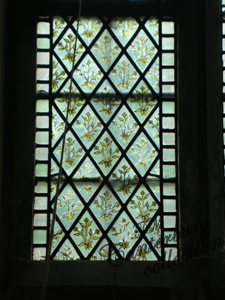
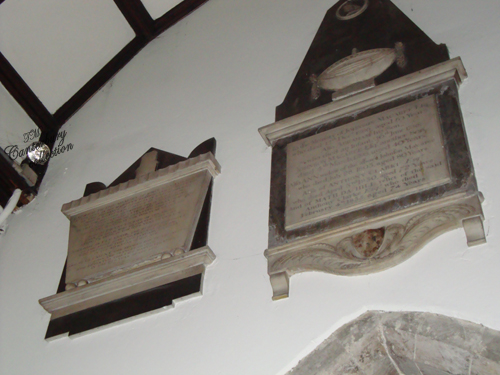
"Sir William Rooke, of St. Lawrence, in St. Paul's parish, Canterbury, was a suffering loyalist in the reign of Charles I. At the restoration he was made a justice of the peace, deputy lieutenant, and high sheriff for several years, and nearly four in the reign of James II. He commanded a regiment of foot, and at the same time a troop of horse, and died March 10, 1690, in his 70th year; he was buried in St. Paul's church, Canterbury. By Jane, daughter and coheir of Thomas Finch, of Cobtree, Esq. in Allington parish, near Maidstone, he had Sir George, Mary, Ursula, Ann, Thomas, Jane and Finch Rooke."
The British Critic...1809
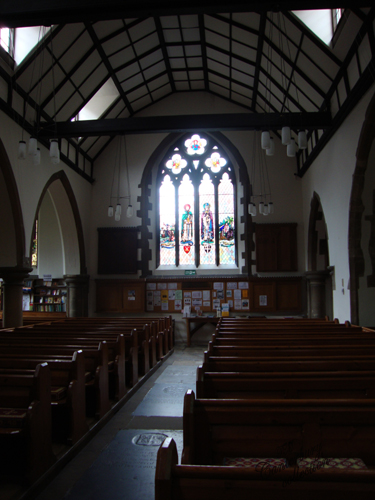
"In St. Paul's Church, which stands in the Eastern Suburb without Bur-Gate, is a mural monument in memory of Sir William Rooke, Knt. of St. Lawrence, who was imprisoned several years for his loyalty; but, after the Restoration, was made a Deputy Lieutenant of this County, and was also High Sheriff of Kent for several years, in the reigns of Charles the Second and James the Second: his son, Sir George Rooke, was also buried here. On a slab in the pavement, are Brasses of a male and female, with an inscription and two shields of arms beneath their feet. On the shield below the woman, a fess embattled, two stars in chief: on the other shield, the same arms, impaling, on a fess between three boars' heads erased, three lances: the inscription is as follows:
Epitaphium Joannis
Tivini Armigeri qui
(Armiger = Armor bearer; squire)
obiit xxbiii Nobembris
(obiit = he or she died) (Nobembris = November)
1581
Glauditur Hoc tumulo, Joannes ille Twiynus,
qui pueros docuit berba Latina loqui:
(Pueros = children?) (Latina loqui = to speak Latin?)
Duiq' urbem banc rexit praetor, turbante biato
(Praetor = official elected by the Romans who served as a judge)
Rem populi et regni seditione bafra
Duic Deus in christi mundato sanguine donet
Loeta resurgenti', Iector, idemq' tibi.
A?ibit Dominus."
The Beauties of England and Wales...1808
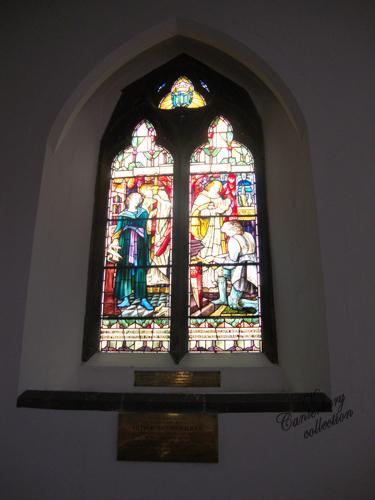
The stone of which a representation is sent herewith, according to tradition commemorates an unfortuante duel which formery occurred at Canterbury, between two officers of the garrison. One of the victims of it was killed on the spot; the other expired as he passed an adjoining stile, while withdrawing from the scene of combat. Some friend recorded the fall of one of the parties by a rude inscription on a stone of the boundary wall of St. Augustine's Abbey, at the place where the event occurred. It is on a Caen stone, 7 1/2" each way, and is by the footpath leading from St. Martin's church to the vicinity of St. Gregory's Barracks, and is near a doorway now stopped up.
Mr. Rooke was of a Kentish family formerly of some note, and, according to a printed pedigree, was buried at St. Paul's, Canterbury.
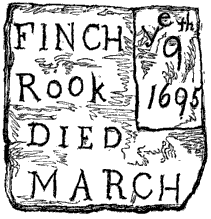
1696 An inquisition is taken before the Coroner of Canterbury, on view of the bodies of Anthony Buckeredge and Finch Rooke, gents. who were both killed, in a duel fought by them with swords, in the North-Homes, in Northgate, Canterbury. (Bunce's Minutes)
The above relic maybe of little importance; but the mention of St. Augustine's Abbey affords an opportunity of referring to the gratifying subject of its now being secured from further spoliation by the recent purchase of A. J. Beresford Hope, esq. M.P. The rapid destruction of Ethelbert's tower within the precinct of the Abbey leaves it doubtful how much longer these ancient remains might otherwise have survived. The above fabric, which was a happy, indeed an almost unrivalled, specimen of architecture, and which might have continued standing for many centuries, having been, as Mr. Britton informs us in his Picturesque Antiquities of English Cities, much undercut to furnish materials to be used in building a gentleman's house, fell down in part in 1824. The remainder was pulled down, notwithstanding the regret generally felt at the destruction of so fine a monument of antiquity, to avoid the expense which the adding a requisite support by masonry would have occasioned. Yours, &c. B.P.
The Gentlemen's Magazine 1845 (Finch Rooke's father, Sir William Rooke had died just 5 years previous to this in 1690)

Richard Berne, of Canterbury, 28th April, 1461. My body to be buried in the aisle before the cross, in the south part of St. Paul's, at Canterbury. To the rebuilding of the bell tower of the monastery of St. Augustine ix l. to be paid as soon as the said work shall be begun; to the prisoners of the Castle of Canterbury and of Westgate vi s. viii d. each; to the Prioress of the Church of St. Sepulchre, towards the works of her Church xiii s. iv d.; to the repair of the highway leading towards Sandwich, by St. Martin's Hill and the Fishpoole x l.; towards the repair of the highway in the Winecheape, between Bircholle's Place and St. James's Hospital x l.; to Joan, my wife, my furniture and my best cart, and my five horses fit to draw it, with all their harness; to the building of the new bell tower of Tenterden vi s. viii d. Richard my son. Proved 7th May 1461, at Canterbury. Testament a Vetusta
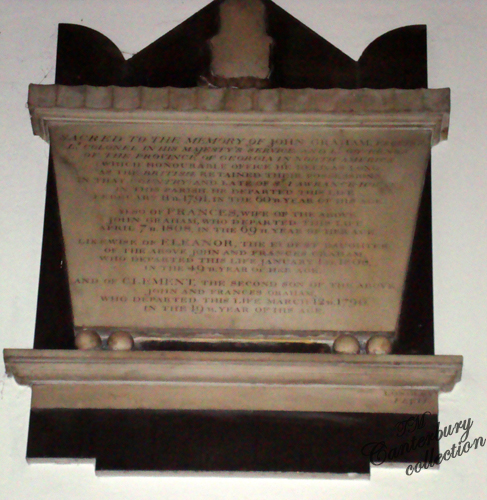
Sacred to the memory of John GRAHAM
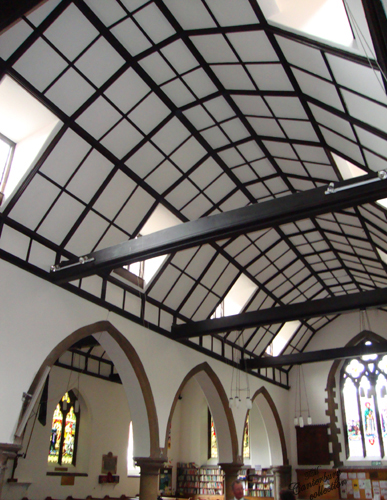
TERRY'S
Marriage of Adam TERRY and Margaret WELLARD St. Pauls, Canterbury December 25, 1794
Marriage of Sarah TERRY and William BEAN St. Pauls, Canterbury 1798
Christening of a John Terrie, son of Michaell Terrie on March 31, 1616, at St. Paul, Canterbury
Marriage, April 3, 1899 - William TERRY (age 22), carpenter of Havelock Street, married Harriet Jane MOAT (20 years) of 39 Broad Street. Fathers: William TERRY, surveyor and Henry MOAT, Labourer. Witnesses: Henry MOAT, Arthur E. MOAT and Charlotte M. WILSON
Marriage, April 23, 1844. Edward John HAYWARD (21 years), labourer of Chantry Lane and Caroline TERRY (minor). Fathers, Edward HAYWARD, farmer and John TERRY, labourer. Witnesses: William MORRIS and Eleanor PIPER.
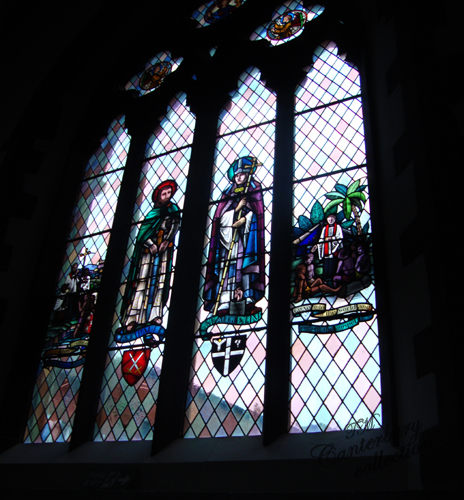
August 23, 1902 (Kentish Gazette & Canterbury Press)
marriage
WILLIAMSON - GODFREY. - August 16, at St. Paul's Church, Canterbury, by the Rev. A. W. Payne, Frederick John, eldest son of Mr. Williamson of Teynham, to Elizabeth Alice Godfrey, widow of the late Corporal J. A. GODFREY, and third daughter of Mr. James INGLETON, of Canterbury.

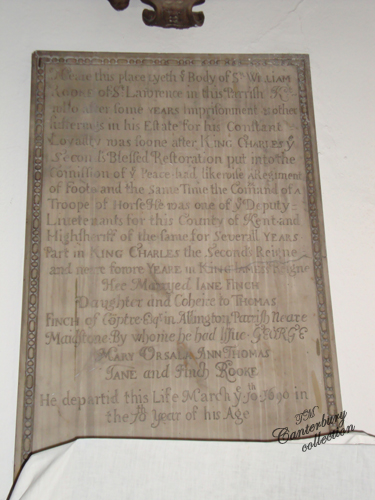
Neare this place lyeth ye Body of Sr. William Rooke of St. Lawrence in this parish
1808 - Thomas Anthony Mutlow, son of Thomas Mutlow, of Gloucester. Minor Canon of Canterbury Cathedral, 1803-1828. Rector of St. Andrew's, with St. Martin's, and Vicar of St. Paul's Canterbury, 1808. Vicar of Preston near Wingham, Kent, 1828.
1838 - J. Edward Nassau Molesworth
1847 - Rev. William John Chesshyre
1858 - Rev. W. J. Chesshyre
Death, Feb 1, 1859, at Canterbury, aged 53, the Rev. William John Chesshyre, M.A., one of the Canons of Canterbury. Mr. Chesshyre was the son of Rear-Adm. Chesshyre, and was educated at Rugby and Balliol College, Oxford. In 1841 he was presented by Archbishop Howley to the united parishes of St. Martin and St. Paul, Canterbury, in which city his influence, derived from his earnest character and a considerable private estate, was most beneficially exerted. To him is in a great degree due the restoration of the interesting churches of his parishes, and the foundation of parochial and general schools in the archiepiscopal city. He afterwards became tutor to the sons of the Earl of Egremont, was sent to Oxford by that nobleman in charge of his youngest son, and was rewarded for his care by presentation to two family benefices. In 1846 Mr. Chesshyre was appointed Rural Dean of Canterbury, and one of the six preachers of the Cathedral. Twice in 1852, and again in 1857 the clergy of the diocese elected him as one of their proctors in Convocation; and, finally in March, 1858, he was presented by the Crown, on the recommendation of Lord Derby, to the stall in Canterbury Cathedral, which had been vacated by the removal of Professor Stanley to Oxford an appointment which was hailed with lively satisfaction by all to whom his character and merits were known. Unhappily Mr. Chesshyre's career of usefulness was drawing to a close. His health had given way; and after a vain resort to the foreign baths, he returned home to die.
Marriage on July 2, 1863 at St. Paul's, Canterbury, Philip Butler, esq., of Yattalunga, South Australia, to Margaret, third daughter of the late Rev. W. J. Chesshyre, M.A., of Barton-court, Canon of Canterbury. Gentlemen's Magazine 1863 *Rev. Chesshyre passed away in 1859
Rev. Herbert Thoams MAITLAND. Born 21 Jan. 1846. Bapt 2 Feb.1846, at St. Peter's Walworth. Of Worchester College, Oxon. Matric. 15 Oct. 1864 Ba.A. 1867, M.A. 1872, Curate of St. Martin and St. Paul, Canterbury. Rector of ?ostling, Kent 1881-84. Vicar of St. Saviour's, Walthamstow, Essex.
1889 - Rev. Leslie Ellis Goodwin, M.A. Rev. - Carter, Curate
1903 - Rev. Edward Hoare Hardcastle M.A. Hours of Service: 8 & 11 am. & 6:30 pm. ; daily 10 am & 4 pm. in winter, and 10 am & 6 pm in summer
1917 - Baptisms 3rd Sunday in the month. Vicar, Rev. W. L. Green (M.A.); Curates, Rev. C.E.P. Antram and Rev. A.H. Taylor (B.A.); Churchwardens, Messrs. F.Wacher and F.A. Parry

